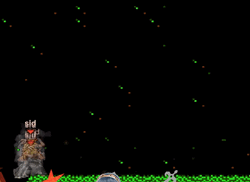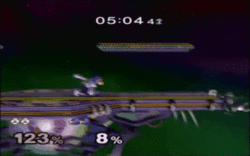Spacing: Difference between revisions
(Gave example from Myztek's Gamefaq discussion, found on link below.) |
mNo edit summary |
||
| (12 intermediate revisions by 12 users not shown) | |||
| Line 1: | Line 1: | ||
{{ArticleIcons|series=y}} | {{ArticleIcons|series=y}} | ||
{{cleanup| | {{redirect|Space|the Dutch player|Smasher:Space}} | ||
'''Spacing''' | {{for|the American smasher|Smasher:Space (New England)}} | ||
{{cleanup|Needs elaboration on advanced spacing and more gifs to demonstrate precise interactions}} | |||
[[File:Spacing.gif|thumb|250px|{{Sm|Zhu}} using {{SSBM|Falco}}'s aerial drift to space around {{Sm|Mew2King}}'s shield grab, showing very precise awareness of {{SSBM|Sheik}}'s [[grab]] range.]] | |||
'''Spacing''' describes both a player's awareness of an opponent's options and said player's ability to avoid and counter them. At its core, spacing is the concept of gauging the distance between a player and their opponent(s), primarily during the [[neutral game]]. Spacing is an integral skill needed to succeed in competitive ''Smash'', as every single interaction is decided by who picked the better timing and position in an exchange of actions. This is a concept present in every fighting game in existence and can extend further into other genres. | |||
At its simplest form, spacing tests knowledge of how characters can move before, during, and after an action, and the periods of vulnerability and invulnerability of those actions. Every action in-game has a certain timing and area of effect; to "space around" an action means to use knowledge of both its timing and range to pick the appropriate option to counter it. | |||
At the lowest level of competitive play, spacing only involves superficial comparison of the hitbox ranges of attacks with very little nuanced timing due to lack of [[tech skill]] and knowledge of positioning. At this level of play, the most successful characters tend to be characters with long raw hitbox range — particularly [[disjoint]]s — like [[Marth]], or characters with fast attacks such as [[Sheik]]. At this stage, attack animations are a common point of reference, and this can be misleading and lead to undershooting or overshooting one's attacks. This type of play is often rewarded in [[online play]], in which frame-by-frame interactions are often less important due to [[lag]] and input delay. | |||
[[File:TerryThreatBubble.gif|250px|thumb|An overlap of all of {{SSBU|Terry}}'s moves from the same position, forming a threat bubble. Made by sids.]] | |||
As the level of play increases, players reach a level at which they are able to extrapolate how hitboxes can move relative to their character's movement, as well as a vague awareness of their actual hurtbox. This is normally when a player has acknowledged the concept of threat bubbles, which are often instrumental for visual learners. At this level of play, players are able to move in and out of attack ranges by using footsies, albeit fairly imprecisely, with simple movement options like [[dash dancing]], [[short hop fast fall]]ing, or in ''Melee'', [[wavedashing]]. Players tend to get a grasp of how to bait out attacks and punish them, an important skill for succeeding all the way into high-level gameplay. | |||
At the highest level of play, players have internalized the knowledge of their character's movement and attacks to the point where they can move around attacks at very precise distances. This is normally achieved by visualizing their character's threat bubble to consistently win interactions, as well as making better use of advanced grounded and aerial movement. Acknowledging that spacing must have a purpose is also essential, as pressure without purpose often leads to taking unnecessary damage, something a top-level player seeks to actively avoid. Patience and discipline is pivotal to succeeding, responding to the opponent's options and watching them more than oneself. | |||
==External links== | ==External links== | ||
*[ | *[https://www.youtube.com/watch?v=RfBuAo_Bfvw Lucien's spacing tutorial] | ||
{{AllGames|Techniques}} | {{AllGames|Techniques}} | ||
Latest revision as of 05:58, February 8, 2024
- "Space" redirects here. For the Dutch player, see Smasher:Space.
Spacing describes both a player's awareness of an opponent's options and said player's ability to avoid and counter them. At its core, spacing is the concept of gauging the distance between a player and their opponent(s), primarily during the neutral game. Spacing is an integral skill needed to succeed in competitive Smash, as every single interaction is decided by who picked the better timing and position in an exchange of actions. This is a concept present in every fighting game in existence and can extend further into other genres.
At its simplest form, spacing tests knowledge of how characters can move before, during, and after an action, and the periods of vulnerability and invulnerability of those actions. Every action in-game has a certain timing and area of effect; to "space around" an action means to use knowledge of both its timing and range to pick the appropriate option to counter it.
At the lowest level of competitive play, spacing only involves superficial comparison of the hitbox ranges of attacks with very little nuanced timing due to lack of tech skill and knowledge of positioning. At this level of play, the most successful characters tend to be characters with long raw hitbox range — particularly disjoints — like Marth, or characters with fast attacks such as Sheik. At this stage, attack animations are a common point of reference, and this can be misleading and lead to undershooting or overshooting one's attacks. This type of play is often rewarded in online play, in which frame-by-frame interactions are often less important due to lag and input delay.

As the level of play increases, players reach a level at which they are able to extrapolate how hitboxes can move relative to their character's movement, as well as a vague awareness of their actual hurtbox. This is normally when a player has acknowledged the concept of threat bubbles, which are often instrumental for visual learners. At this level of play, players are able to move in and out of attack ranges by using footsies, albeit fairly imprecisely, with simple movement options like dash dancing, short hop fast falling, or in Melee, wavedashing. Players tend to get a grasp of how to bait out attacks and punish them, an important skill for succeeding all the way into high-level gameplay.
At the highest level of play, players have internalized the knowledge of their character's movement and attacks to the point where they can move around attacks at very precise distances. This is normally achieved by visualizing their character's threat bubble to consistently win interactions, as well as making better use of advanced grounded and aerial movement. Acknowledging that spacing must have a purpose is also essential, as pressure without purpose often leads to taking unnecessary damage, something a top-level player seeks to actively avoid. Patience and discipline is pivotal to succeeding, responding to the opponent's options and watching them more than oneself.

